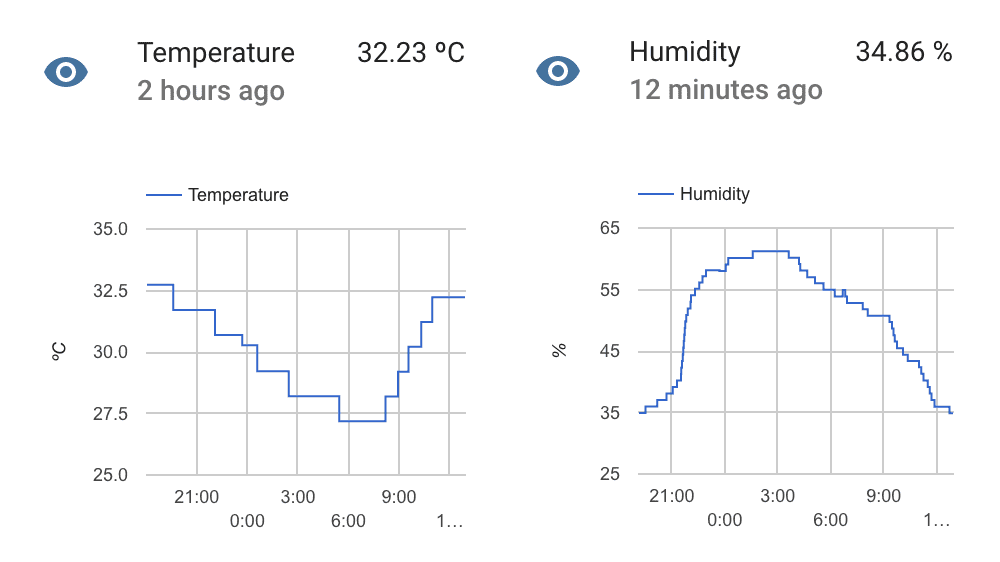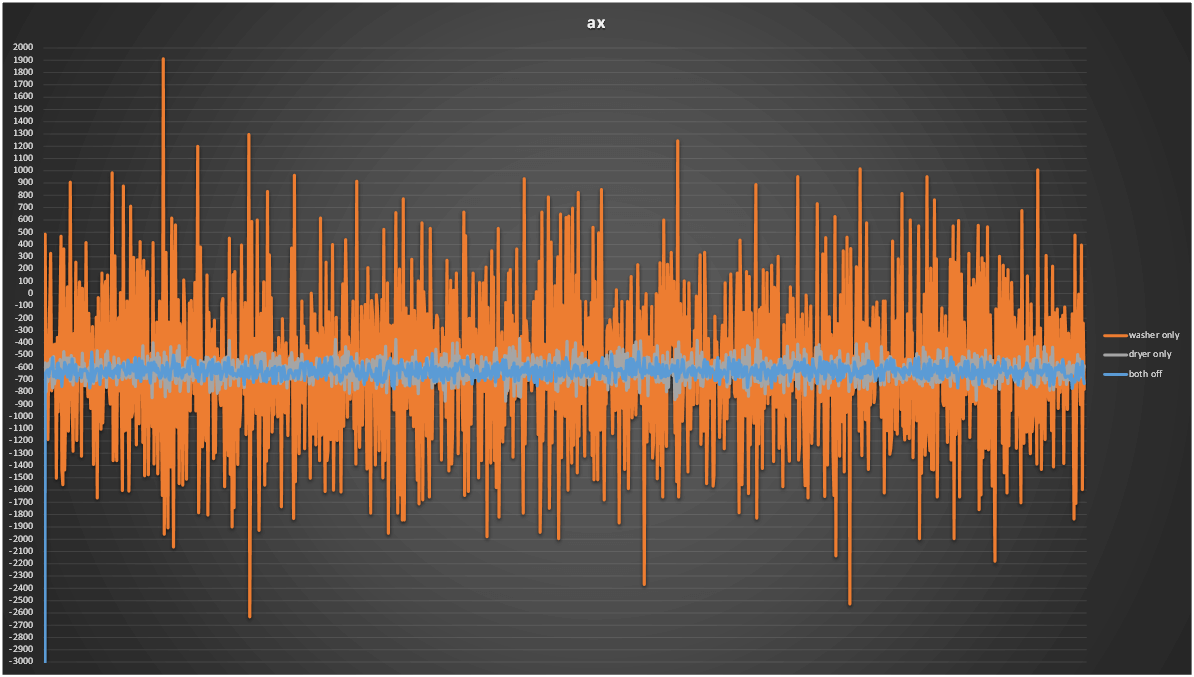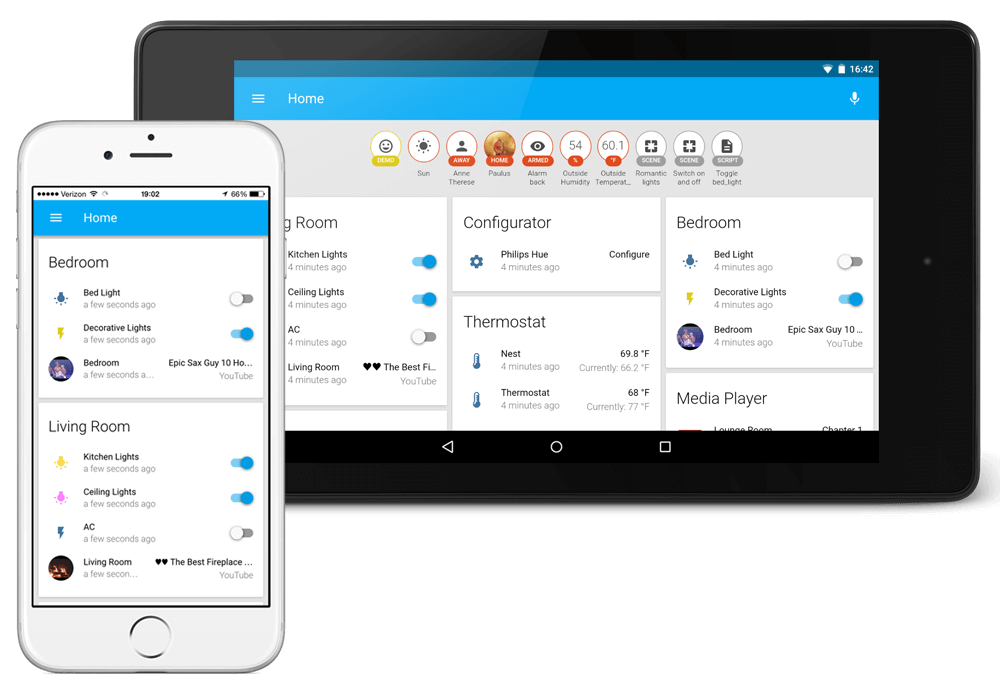Blog
0.7.6: Amazon FireTV, Radiotherm thermostats
After two weeks of hard work I’m proud to announce the release of Home Assistant v0.7.6. For this release the main focus was bugs, test coverage and documentation. And we exceeded expectations on all three fronts. Bugs have been squashed, test coverage increased to 85%
Changes



- Device tracker: Newer TP-Link routers now supported (@mKeRix
) - Alarm Control Panel: Manual alarm added (@sfam
) - Thermostat: Radiotherm now supported (@toddeye
) - Media Player: Amazon FireTV now supported (@happyleavesaoc
) - Device Tracker: Geofancy now supported (@wind-rider)
- New component Shell Command can expose shell commands as services (@balloob
) -
Scripts can now be customized using
customizekey inconfiguration.yaml(@balloob) - Light: Hyperion now supported (@MakeMeASandwich)
- Sensor: aRest can now also read out pins (@balloob
) - Sensor: Forecast.io now supports specifying units in
configuration.yaml(@balloob) - Thermostat: Heat Control has been completely rewritten (@balloob
) - Switch: Rest now supported (@bachp
) - Media Player: Plex can now be auto discovered and configure itself (@tomduijf
) -
Downloader will now treat relative paths based on config dir (@tomduijf
) - Line Charts will use interpolation for sensor data and show current and target temperature for thermostats (@balloob
) - Device Tracker: OpenWRT via ubus now supported (@krzynio
)
Report the temperature with ESP8266 to MQTT
{::options coderay_line_numbers=“table” /}
I recently learned about the ESP8266, a $5 chip that includes WiFi and is Arduino compatible. This means that all your DIY projects can now be done for a fraction of the price.
For this tutorial, I’ll walk through how to get going with ESP8266, get the temperature and humidity and report it to MQTT where Home Assistant can pick it up.
 Picture of the final setup (+ 2 LED for decoration)
Picture of the final setup (+ 2 LED for decoration)
 Home Assistant will keep track of historical values and allow you to integrate it into automation.
Home Assistant will keep track of historical values and allow you to integrate it into automation.
0.7.5: Blinkstick, SNMP, Telegram
We discovered two issues annoying enough to warrant the release of 0.7.5:
- Home Assistant package did not include the CloudMQTT certificate.
- A bug in the core caused issues when some platforms are loaded twice.
This release also includes some new platforms (because they keep coming!):



- Light: blinkstick platform added (@alanbowman
) - Device Tracker: SNMP platform added (@tomduijf
) - Light: rfxtrx platform added (@badele
) - Switch: rfxtrx platform added (@badele
) - Notify: telegram platform added (@fabaff
)
Also, the media player was extended by @maddox
Home Assistant goes geo with OwnTracks
A few weeks have past and it is time again for another release: version 0.7.4. This time we’re very glad to be able to introduce brand new integration with OwnTracks to allow tracking of people on a map. The geo support consists of three different parts:
- OwnTracks platform for the device tracker to get locations for devices
- Brand new zone component to define zones to identify locations and trigger automation
- A map in the UI to see all this (see it in action in the demo)
We have added a new getting started section to get up and running.
 Map in Home Assistant showing two people and three zones (home, school, work)
Map in Home Assistant showing two people and three zones (home, school, work)
Ofcourse more things happened in the last three weeks. I’m moving away from my usual long post to a short summary of highlights:

- Sensor: rest platform added (@fabaff
) - Alarm Control Panel: MQTT platform added (@sfam
) - Media Player: Plex platform added ([@miniconfig](https://github.com/miniconfig
, @adrienbrault ) - Dev Tools: services can now show description of fields (@balloob
) - MQTT: Support for certificates and improved error reporting (@balloob
) - Light: limitlessled platform extended with white light support (@auchter
) - Fuzzy matching for scenes (@pavoni
) - Scene support for media player (@maddox
)
Alarms, Sonos and iTunes now supported
It’s like someone opened a can of rock solid developers and emptied it above our chat channel
See GitHub
Migration note: the scheduler component has been removed in favor of the automation component.
Sonos
 Sonos support has been added by @rhooper
Sonos support has been added by @rhooper
iTunes and airplay speakers
 @maddox
@maddox
# Example configuration.yaml entry
media_player:
platform: itunes
name: iTunes
host: http://192.168.1.50
port: 8181
Remote Monitoring with Glances
 Inspired by a [feature requests](https://github.com/home-assistant/home-assistant/issues/310) I started looking into the available options to do monitoring of remote hosts. The feature request is about displaying system information in a similar way than the [systemmonitor](/integrations/systemmonitor) sensor does it for the local system. After a while I started to think that it would be a nice addition for a small home network where no full-blown system monitoring setup is present.
Read on →
Inspired by a [feature requests](https://github.com/home-assistant/home-assistant/issues/310) I started looking into the available options to do monitoring of remote hosts. The feature request is about displaying system information in a similar way than the [systemmonitor](/integrations/systemmonitor) sensor does it for the local system. After a while I started to think that it would be a nice addition for a small home network where no full-blown system monitoring setup is present.
Read on →
Home Assistant meets IFTTT
Today we announce the release of Home Assistant v0.7.2 which includes brand new support by @sfam
It is now possible to disable your irregation system if it is going to be cloudy tomorrow or tweet if your smoke alarm goes off.

Head over to the setup instructions to get started with IFTTT. Click the read more button for some example recipes.
Read on →Using MQTT with Home Assistant
{::options coderay_line_numbers=“table” /}
 MQTT
MQTT
A great example is shown in a Laundry Automation post in this blog.
This post will give you a small overview of some other possibilities on how to use MQTT with Home Assistant.
Read on →0.7: Better UI and improved distribution
As Home Assistant is gaining more and more users we started to feel the pain from not having a proper release mechanism. We had no version numbering and required users to checkout the source using Git to get started. On top of that, as the number of devices that we support keeps raising, so did the number of dependencies that are used. That’s why we decided to change the way we roll. From now on:
- Each release will have a version number, starting with version 0.7. This was chosen because it shows that we have been around for some time but are not considering ourselves to be fully stable.
- Each release will be pushed to PyPi. This will be the only supported method of distribution.
- Home Assistant is available after installation as a command-line utility
hass. - The default configuration location has been moved from
configin the current working directory to~/.homeassistant(%APPDATA%/.homeassistanton Windows). - Requirements for components and platforms are no longer installed into the current Python environment (being virtual or not) but will be installed in
<config-dir>/lib.
A huge shout out to Ryan Kraus
And while Ryan was fixing distribution, I have been hard at work in giving Home Assistant a face lift. We already looked pretty good but lacked proper form of organization for users with many devices. The new UI moves away from a card per entity and has cards per group and domain instead. The demo has been updated so give it a spin.
Read on →Laundry Automation: insight and notifications
This is a guest post by Home Assistant user and contributor Nolan Gilley
In our house, laundry has been a struggle for quite some time. Our washer and dryer both lack a buzzer which leads to forgotten laundry, and stinky mess that needs to be rewashed. I decided to create a solution by monitoring the washer and dryer myself with some cheap electronics.
As an avid user of Home Assistant, I decided it would be the perfect application to manage the UI and notification system. Now all I needed was a way to monitor the washer and dryer. I tried using sound sensors but found them unreliable. I ended up opting for an accelerometer attached to the back of each appliance. I also added magnetic reed switches on the doors of the washer and dryer to detect if the doors are open or closed. I connected the accelerometers and reed switches to a Moteino
After taking some sample data from the accelerometers while each appliance was in operation, I decided to plot the data to help determine the proper thresholds of when the devices were running or off. I had to do this in order to get precise ranges so the dryer sensor wouldn’t get tripped by the washer or vice versa. In the plot below you can see the acceleration in the x direction for the accelerometer connected to the washing machine. It’s easy to see when the washing machine is in operation here. I used the same technique for the dryer’s accelerometer.
 Graph showing the accelerometer data
Graph showing the accelerometer data
